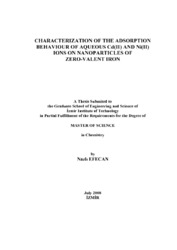Please use this identifier to cite or link to this item:
https://hdl.handle.net/11147/3936Full metadata record
| DC Field | Value | Language |
|---|---|---|
| dc.contributor.advisor | Shahwan, Talal | - |
| dc.contributor.author | Efecan, Nazlı | - |
| dc.date.accessioned | 2014-07-22T13:52:47Z | - |
| dc.date.available | 2014-07-22T13:52:47Z | - |
| dc.date.issued | 2008 | - |
| dc.identifier.uri | http://hdl.handle.net/11147/3936 | - |
| dc.description | Thesis (Master)--İzmir Institute of Technology, Chemistry, İzmir, 2008 | en_US |
| dc.description | Includes bibliographical references (leaves: 50-54) | en_US |
| dc.description | Text in English; Abstract: Turkish and English | en_US |
| dc.description | xi, 54 leaves | en_US |
| dc.description.abstract | Iron nanotechnology is recently concieved as a promising tool in environmental remediation. By virtue of their high surface/volume ratio, iron nanoparticles were shown to demonstrate outstanding sequestration capacity for various organic and inorganic pollutants.In this work iron nanoparticles were synthesized using the borohydride-reduction method. The obtained material showed chain like morphology, with the diameter of the nanoparticles being with in 20-80 nm range. HR-TEM images showed that the nanoparticles have a core-shell structure, with the core containing iron in its zero-valent state, while the shell is composed of iron oxides (Fe2O3, Fe3O4, FeOOH)and is generally < 3 nm in thickness.Nano-sized zero valent iron (nZVI) was then tested as a sorbent material for aqueous Cd2+ and Ni2+ ions. The uptake of these ions was investigated under various experimental conditions like time, concentration, pH, repititive application, and liquid/solid ratios. In addition, the uptake of these ions was compared with that of Cu2+, Zn2+, and Sr2+ in order to assess the effect of the reduction potential on the extent of removal.The results showed that nZVI is a very effective sorbent in terms of both kinetics and capacity of removal of the ions. Under the investigated conditions, the uptake reached equilibrium in less than one hour of contact time. Up to the initial concentration of 500 mg/L, the ions were removed almost completely utilizing an nZVI amount of 0.025 g and a solution volume of 10 ml. According to XRD and XPS results, both of Cd2+ and Ni2+ ions were fixed by nZVI through a non-reductive mechanism, that seems to be dominated by interaction of these ions with the exposed iron oxyhydroxide groups at the interface with the solution. | en_US |
| dc.language.iso | en | en_US |
| dc.publisher | Izmir Institute of Technology | en_US |
| dc.rights | info:eu-repo/semantics/openAccess | en_US |
| dc.subject.lcc | TP248.25.N35 E271 2008 | en |
| dc.subject.lcsh | Nanotechnology--Laboratory manuals | en |
| dc.subject.lcsh | Iron--Analysis | en |
| dc.title | Characterization of the Adsorption Behaviour of Aqueous Cd (ii) and Ni (ii) Ions on Nanoparticles of Zero-Valent Iron | en_US |
| dc.type | Master Thesis | en_US |
| dc.institutionauthor | Efecan, Nazlı | - |
| dc.department | Thesis (Master)--İzmir Institute of Technology, Chemistry | en_US |
| dc.relation.publicationcategory | Tez | en_US |
| dc.identifier.wosquality | N/A | - |
| dc.identifier.scopusquality | N/A | - |
| item.openairecristype | http://purl.org/coar/resource_type/c_18cf | - |
| item.languageiso639-1 | en | - |
| item.openairetype | Master Thesis | - |
| item.grantfulltext | open | - |
| item.fulltext | With Fulltext | - |
| item.cerifentitytype | Publications | - |
| Appears in Collections: | Master Degree / Yüksek Lisans Tezleri | |
Files in This Item:
| File | Description | Size | Format | |
|---|---|---|---|---|
| T000724.pdf | MasterThesis | 3.07 MB | Adobe PDF |  View/Open |
CORE Recommender
Page view(s)
234
checked on Mar 31, 2025
Download(s)
126
checked on Mar 31, 2025
Google ScholarTM
Check
Items in GCRIS Repository are protected by copyright, with all rights reserved, unless otherwise indicated.